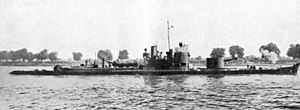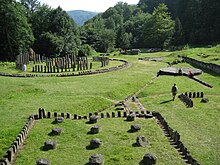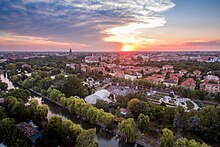| This Wikipedia page has been superseded by Portal:Romania and is retained primarily for historical reference. |
| Note: Article entries are now being transcluded directly on the main portal page. However, this page should be retained for historical reference. |
Selected article 1
Portal:Romania/Selected article/1 Căile Ferate Române (Romanian pronunciation: [ˈkə.ile feˈrate roˈmɨne]; abbreviated as the CFR) was the state railway carrier of Romania. The company was dissolved on 1 October 1998 by splitting into several successor companies. CFR as an entity existed from 1880, even though the first railway on current Romanian territory was opened in 1854. CFR was divided into four autonomous companies:
- CFR Călători, responsible for passenger services;
- CFR Marfă, responsible for freight transport;
- Compania Națională de Căi Ferate CFR, manages the infrastructure on the Romanian railway network; and
- Societatea Feroviară de Turism, or SFT, which manages scenic and tourist railways.
CFR was headquartered in Bucharest and had regional divisions centered in Bucharest, Brașov, Cluj-Napoca, Constanța, Craiova, Galați, Iași, and Timișoara. Its International Union of Railways code is 53-CFR. (Full article...)
Selected article 2
Portal:Romania/Selected article/2
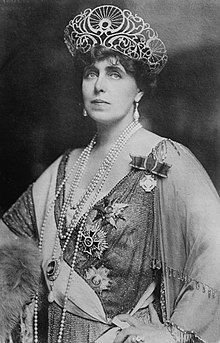
Marie (born Princess Marie Alexandra Victoria of Edinburgh; 29 October 1875 – 18 July 1938) was the last queen of Romania as the wife of King Ferdinand I.
Marie was born into the British royal family. Her parents were Prince Alfred, Duke of Edinburgh (later Duke of Saxe-Coburg and Gotha), and Grand Duchess Maria Alexandrovna of Russia. Marie's early years were spent in Kent, Malta and Coburg. After refusing a proposal from her cousin, the future King George V, she was chosen as the future wife of Ferdinand, then crown prince of Romania, in 1892. Marie was crown princess between 1893 and 1914, and became immediately popular with the Romanian people. (Full article...)
Selected article 3
Portal:Romania/Selected article/3 Romanian cuisine (Romanian: Bucătăria românească) is a diverse blend of different dishes from several traditions with which it has come into contact, but it also maintains its own character. It has been influenced mainly by Turkish but also a series of European cuisines in particular from the Balkan Peninsula and Hungarian cuisine as well as culinary elements stemming from the cuisines of Central Europe.
Romanian cuisine includes numerous holiday dishes arranged according to the mentioned season and holiday since the country has its religious roots in Eastern Orthodoxy. Romanian dishes consist of vegetables, cereals, fruits, honey, milk, dairy products, meat and game. (Full article...)
Selected article 4
Portal:Romania/Selected article/4
Vardar was a Sava-class river monitor built for the Austro-Hungarian Navy as SMS Bosna, but was renamed SMS Temes (II) before she went into service. During World War I, she was the flagship of the Danube Flotilla, and fought the Serbian Army, the Romanian Navy and Army, and the French Army. She reverted to the name Bosna in May 1917, after the original SMS Temes was raised and returned to service. After brief service with the Hungarian People's Republic at the end of the war, she was transferred to the newly created Kingdom of Serbs, Croats and Slovenes (later Yugoslavia), and renamed Vardar. She remained in service throughout the interwar period, although budget restrictions meant she was not always in full commission.
During the German-led Axis invasion of Yugoslavia in April 1941, she was the flagship of the 1st Monitor Division, and along with her fellow monitor Sava, she laid mines in the Danube near the Romanian border during the first few days of the invasion. The two monitors fought off several attacks by the Luftwaffe, but were forced to withdraw to Belgrade. Due to high river levels and low bridges, the monitors' navigation was difficult, and they were scuttled by their crews on 11 April. Some of her crew may have been killed when a demolished bridge collapsed onto a tugboat after they abandoned ship. Some tried to escape cross-country towards the southern Adriatic coast, but most surrendered to the Germans at Sarajevo on 14 April. The remainder made their way to the Bay of Kotor, where they were captured by the Italian XVII Corps on 17 April. (Full article...)
Selected article 5
Portal:Romania/Selected article/5
Built in murus dacicus style, the six Dacian Fortresses of the Orăștie Mountains (Romanian: Cetăți dacice din Munții Orăștiei), in Romania, were created in the 1st centuries BC and AD as protection against Roman conquest, and played an important role during the Roman–Dacian wars.
Their extensive and well-preserved remains present a picture of a vigorous and innovative ancient civilization. Today, treasure-hunters sometimes search the area, as Romania lacks legislation in this domain (see Archaeological looting in Romania). (Full article...)
Selected article 6
Portal:Romania/Selected article/6 The founding of Wallachia (Romanian: descălecatul Țării Românești), that is the establishment of the first independent Romanian principality, was achieved at the beginning of the 14th century, through the unification of smaller political units that had existed between the Carpathian Mountains, and the Rivers Danube, Siret and Milcov.
Prior to the consolidation of Wallachia, waves of nomadic peoples – the last of them being the Cumans and the Mongols – rode across the territory. The territory became a frontier area between the Golden Horde (the westernmost part of the Mongol Empire) and the Kingdom of Hungary after 1242. The Romanians in Muntenia, east of the Olt River, had to pay tribute to the Mongols; and west of the river, in Oltenia, they were oppressed by the Bans of Severin, appointed by the Kings of Hungary. The Golden Horde's domination decreased in the region at the end of the 13th century, and at that time the Kingdom of Hungary also underwent a strong political crisis. These events enabled the incipient states of the territory to consolidate their autonomy. (Full article...)
Selected article 7
Portal:Romania/Selected article/7
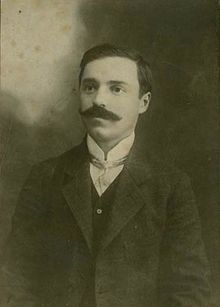
Panait Cerna (Romanian pronunciation: [panaˈit ˈt͡ʃerna]; Bulgarian: Панайот Черна, Panayot Cherna, born Panayot Stanchov or Panait Staciov; August 26 or September 25, 1881 – March 26, 1913) was a Romanian poet, philosopher, literary critic and translator. A native speaker of Bulgarian, Cerna nonetheless wrote in Romanian, and developed a traditionalist style which was connected with classicism and neoclassicism. Praised by the conservative literary society Junimea, he was promoted by its leader Titu Maiorescu, as well as by Maiorescu's disciples Mihail Dragomirescu and Simion Mehedinţi. Cerna became the group's main representative during its decline, contributing to both major Junimist magazines, Convorbiri Literare and Convorbiri Critice. He also contributed pieces to the traditionalist magazine Sămănătorul, and was briefly affiliated with other literary journals.
A graduate of the University of Bucharest, Cerna completed his studies in the German Empire. There, he attended the University of Berlin and the University of Leipzig, befriending the self-exiled Romanian dramatist Ion Luca Caragiale and the literary critic Paul Zarifopol. Cerna died in Leipzig at the age of thirty-one, after a long battle with tuberculosis. (Full article...)
Selected article 8
Portal:Romania/Selected article/8 The Middle Ages in Romania began shortly after the withdrawal of the Roman legions from the former Roman province of Dacia in the late 3rd century and with the start of the Early Middle Ages and the Migration Period that followed afterwards respectively. It subsequently came to an end with the reign of Domn Michael the Brave (1593–1601) who managed, for a short time between 1599 and 1600, to rule Wallachia, Moldavia, and Transylvania together, the three principalities whose territories were to be united some three centuries later to form modern and contemporary Romania.
Over most of this period, Banat, Crișana, Maramureș, and Transylvania – now regions in Romania to the west of the Carpathian Mountains – were part of the Kingdom of Hungary. They were divided into several types of administrative units, such as "counties" and "seats". The heads of the Transylvanian counties or "counts" were subordinated to a special royal official called voivode, but the province was seldom treated as a single unit, since the Székely and Saxon seats were administered separately. In the kingdom, Romanian peasants, being Orthodox, were exempt from the tithe, an ecclesiastical tax payable by all Roman Catholic commoners. However, Romanian noblemen slowly lost the ability to participate in political life, as the 14th-century monarchs pursued a zealous pro-Catholic policy. Their position became even worse after 1437 when the so-called "Union of Three Nations", an alliance of the Hungarian noblemen, the Székelys, and the Saxons, was formed in order to crush the Bobâlna peasant uprising. (Full article...)
Selected article 9
Portal:Romania/Selected article/9
Timișoara (UK: /ˌtɪmɪˈʃwɑːrə/, US: /ˌtiːmiː-/, Romanian: [timiˈʃo̯ara] ; German: Temeswar [ˈtɛmɛʃvaːɐ̯] , also Temeschwar or Temeschburg; Hungarian: Temesvár [ˈtɛmɛʃvaːr] ; Serbian: Темишвар, romanized: Temišvar [těmiʃʋaːr]; see other names) is the capital city of Timiș County, Banat, and the main economic, social and cultural centre in Western Romania. Located on the Bega River, Timișoara is considered the informal capital city of the historical Banat region. From 1848 to 1860 it was the capital of the Serbian Vojvodina and the Voivodeship of Serbia and Banat of Temeschwar. With 250,849 inhabitants at the 2021 census, Timișoara is the country's fifth most populous city. It is home to around 400,000 inhabitants in its metropolitan area, while the Timișoara–Arad metropolis concentrates more than 70% of the population of Timiș and Arad counties. Timișoara is a multicultural city, home to 21 ethnic groups and 18 religious denominations. Historically, the most numerous were the Swabian Germans, Jews and Hungarians, who still make up 6% of the population in Timișoara.
Conquered in 1716 by the Austrians from the Ottoman Turks, Timișoara developed in the following centuries behind the fortifications and in the urban nuclei located around them. During the second half of the 19th century, the fortress began to lose its usefulness, due to many developments in military technology. Former bastions and military spaces were demolished and replaced with new boulevards and neighbourhoods. Timișoara was the first city in the Habsburg monarchy with street lighting (1760) and the first European city to be lit by electric street lamps in 1884. It opened the first public lending library in the Habsburg monarchy and built a municipal hospital 24 years ahead of Vienna. Also, in 1771 it published the first German newspaper in Southeast Europe (Temeswarer Nachrichten). In December 1989, Timișoara was the starting point of the Romanian Revolution. (Full article...)
Selected article 10
Portal:Romania/Selected article/10
Ion Heliade Rădulescu or Ion Heliade (also known as Eliade or Eliade Rădulescu; Romanian pronunciation: [ˈi.on heliˈade rəduˈlesku]; 6 January 1802 – 27 April 1872) was a Wallachian, later Romanian academic, Romantic and Classicist poet, essayist, memoirist, short story writer, newspaper editor and politician. A prolific translator of foreign literature into Romanian, he was also the author of books on linguistics and history. For much of his life, Heliade Rădulescu was a teacher at Saint Sava College in Bucharest, which he helped reopen. He was a founding member and first president of the Romanian Academy.
Heliade Rădulescu is considered one of the foremost champions of Romanian culture from the first half of the 19th century, having first risen to prominence through his association with Gheorghe Lazăr and his support of Lazăr's drive for discontinuing education in Greek. Over the following decades, he had a major role in shaping the modern Romanian language, but caused controversy when he advocated the massive introduction of Italian neologisms into the Romanian lexis. A Romantic nationalist landowner siding with moderate liberals, Heliade was among the leaders of the 1848 Wallachian revolution, after which he was forced to spend several years in exile. Adopting an original form of conservatism, which emphasized the role of the aristocratic boyars in Romanian history, he was rewarded for supporting the Ottoman Empire and clashed with the radical wing of the 1848 revolutionaries. (Full article...)
Selected article 11
Portal:Romania/Selected article/11

Regulamentul Organic (Romanian: [reɡulaˈmentul orˈɡanik], English: Organic Regulation; French: Règlement Organique; Russian: Органический регламент, romanized: Organichesky reglament) was a quasi-constitutional organic law enforced in 1831–1832 by the Imperial Russian authorities in Moldavia and Wallachia (the two Danubian Principalities that were to become the basis of the modern Romanian state). The document partially confirmed the traditional government, including rule by the hospodars, and set up a common Russian protectorate which lasted until 1854. The Regulament itself remained in force until 1858. Conservative in its scope, it also engendered a period of unprecedented reforms which provided a setting for the Westernization of the local society. The Regulament offered the two Principalities their first common system of government. (Full article...)
Selected article 12
Portal:Romania/Selected article/12
The Yugoslav monitor Sava is a Temes-class river monitor that was built for the Austro-Hungarian Navy as SMS Bodrog. She fired the first shots of World War I just after 01:00 on 29 July 1914, when she and two other monitors shelled Serbian defences near Belgrade. She was part of the Danube Flotilla, and fought the Serbian and Romanian armies from Belgrade to the mouth of the Danube. In the closing stages of the war, she was the last monitor to withdraw towards Budapest, but was captured by the Serbs when she grounded on a sandbank downstream from Belgrade. After the war, she was transferred to the newly created Kingdom of Serbs, Croats and Slovenes (later Yugoslavia), and renamed Sava. She remained in service throughout the interwar period, although budget restrictions meant she was not always in full commission.
During the German-led Axis invasion of Yugoslavia in April 1941, Sava served with the 1st Monitor Division. Along with her fellow monitor Vardar, she laid mines in the Danube near the Romanian border during the first few days of the invasion. The two monitors fought off several attacks by the Luftwaffe, but were forced to withdraw to Belgrade. Due to high river levels and low bridges, navigation was difficult, and Sava was scuttled on 11 April. Some of her crew tried to escape cross-country towards the southern Adriatic coast, but all were captured prior to the Yugoslav surrender. The vessel was later raised by the navy of the Axis puppet state known as the Independent State of Croatia and continued to serve as Sava until the night of 8 September 1944 when she was again scuttled. (Full article...)
Selected article 13
Portal:Romania/Selected article/13
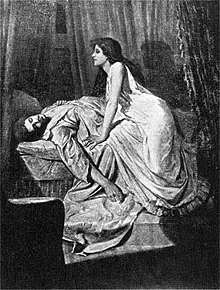
A vampire is a mythical creature that subsists by feeding on the vital essence (generally in the form of blood) of the living. In European folklore, vampires are undead humanoid creatures that often visited loved ones and caused mischief or deaths in the neighbourhoods which they inhabited while they were alive. They wore shrouds and were often described as bloated and of ruddy or dark countenance, markedly different from today's gaunt, pale vampire which dates from the early 19th century.
Vampiric entities have been recorded in cultures around the world; the term vampire was popularized in Western Europe after reports of an 18th-century mass hysteria of a pre-existing folk belief in Southeastern and Eastern Europe that in some cases resulted in corpses being staked and people being accused of vampirism. Local variants in Southeastern Europe were also known by different names, such as shtriga in Albania, vrykolakas in Greece and strigoi in Romania, cognate to Italian strega, meaning 'witch'. (Full article...)
Selected article 14
Portal:Romania/Selected article/14 The colors of the national flag of Romania (Romanian: Drapelul României) has a long history, though the association of the three colors only dates to the 18th century. Red, yellow and blue were found on late 16th-century royal grants of Michael the Brave, as well as shields and banners. Thus, the late 13th century Wijnbergen armorial shows the coat of arms of the Wallachian ruler Litovoi as consisting of a shield of ten vertically alternating gold-and-red bands. The same two colors, gules and or, also appeared on the late 15th century flag and coat of arms of Moldavia, during the reign of Stephen the Great. Then, from the late 16th century until the mid-17th century, the historical coat of arms of Transylvania gradually developed as a shield party per fess, consisting of a black eagle on blue background in the upper field, a dividing red band in the middle, and seven red towers on golden background in the lower field. Finally, in the last quarter of the 18th century, Bukovina gets its own coat of arms from the Habsburg Empire, a blue-and-red shield party per pale with a black aurochs' head in the middle, and three golden six-pointed stars surrounding it. During the Wallachian uprising of 1821, these three colors were present, along others, on the canvas of the revolutionaries' flag and its fringes; for the first time a meaning was attributed to them: "Liberty (blue-sky), Justice (yellow field), Fraternity ( blood)". (Full article...)
Selected article 15
Portal:Romania/Selected article/15
Sviatoslav or Svyatoslav I Igorevich (Old East Slavic: Свѧтославъ Игорєвичь, romanized: Svętoslavŭ Igorevičǐ; Old Norse: Sveinald; c. 943 – 972) was Prince of Kiev from 945 until his death in 972. He is known for his persistent campaigns in the east and south, which precipitated the collapse of two great powers in Eastern Europe, Khazaria and the First Bulgarian Empire. He conquered numerous East Slavic tribes, defeated the Alans and attacked the Volga Bulgars, and at times was allied with the Pechenegs and Magyars (Hungarians).
Following the death of his father Igor in 945, Sviatoslav's mother Olga reigned as regent in Kiev until 962. His decade-long reign over the Kievan Rus' was marked by rapid expansion into the Volga River valley, the Pontic steppe, and the Balkans, leading him to carve out for himself the largest state in Europe. In 969, he moved his seat to Pereyaslavets on the Danube. In 970, he appointed his sons Yaropolk and Oleg as subordinate princes of Kiev and Drelinia, while he appointed Vladimir, his son by his housekeeper and servant Malusha, as the prince of Novgorod. (Full article...)
Selected article 16
Portal:Romania/Selected article/16 Several theories, in great extent mutually exclusive, address the issue of the origin of the Romanians. The Romanian language descends from the Vulgar Latin dialects spoken in the Roman provinces north of the "Jireček Line" (a proposed notional line separating the predominantly Latin-speaking territories from the Greek-speaking lands in Southeastern Europe) in Late Antiquity. The theory of Daco-Roman continuity argues that the Romanians are mainly descended from the Daco-Romans, a people developing through the cohabitation of the native Dacians and the Roman colonists in the province of Dacia Traiana (primarily in present-day Romania) north of the river Danube. The competing immigrationist theory states that the Romanians' ethnogenesis commenced in the provinces south of the river with Romanized local populations (known as Vlachs in the Middle Ages) spreading through mountain refuges, both south to Greece and north through the Carpathian Mountains. Other theories state that the Romanized local populations were present over a wide area on both sides of the Danube and the river itself did not constitute an obstacle to permanent exchanges in both directions; according to the "admigration" theory, migrations from the Balkan Peninsula to the lands north of the Danube contributed to the survival of the Romance-speaking population in these territories.
Political motivations—the Transylvanian Romanians' efforts to achieve their emancipation, Austro-Hungarian and Romanian expansionism, and Hungarian irredentism—influenced the development of the theories, and "national passions" still color the debates. In 2013, authors of The Cambridge History of the Romance Languages came to the conclusion that the "historical, archaeological and linguistic data available do not seem adequate to give a definitive answer" in the debate. Their view was accepted by scholars contributing to The Oxford Guide to the Romance Languages, published in 2016, which reiterates that "the location and extent of the territory where "Daco-Romance" originated" is uncertain. (Full article...)
Selected article 17
Portal:Romania/Selected article/17 The Port of Constanța is located in Constanța, Romania, on the western coast of the Black Sea, 179 nautical miles (332 km) from the Bosphorus Strait and 85 nmi (157 km) from the Sulina Branch, through which the Danube river flows into the sea. It covers 3,926 ha (9,700 acres), of which 1,313 ha (3,240 acres) is land and the rest, 2,613 ha (6,460 acres) is water. The two breakwaters located northwards and southwards shelter the port, creating the safest conditions for port activities. The present length of the north breakwater is 8,344 m (5.185 mi) and the south breakwater is 5,560 m (3.45 mi). The Port of Constanța is the largest on the Black Sea and the 17th largest in Europe.
The favourable geographical position and the importance of the Port of Constanța is emphasized by the connection with two Pan-European transport corridors: IV (high speed railway&highway) and the Pan-European Corridor VII (Danube). The two satellite ports, Midia and Mangalia, located not far from Constanța Port, are part of the Romanian maritime port system under the coordination of the Maritime Ports Administration SA. (Full article...)
Selected article 18
Portal:Romania/Selected article/18
Ciomadul (Hungarian: Csomád) is a dormant volcano in Romania. It is in the Eastern Carpathians, between the spa towns of Băile Tușnad and Balvanyos. Ciomadul lies at the southeastern end of the Carpathian volcanic chain and it is the youngest volcano of the Carpatho-Pannonian region. Ciomadul consists of several lava domes with two embedded explosion craters known as Mohoș and Sfânta Ana, the latter of which contains a crater lake, Lake Sfânta Ana. The dominant volcanic rock at Ciomadul is potassium-rich dacite.
Volcanic activity at Ciomadul commenced with effusive activity about one million years ago. Most of the volcano was constructed between 650,000 – 500,000 years ago. (Full article...)
